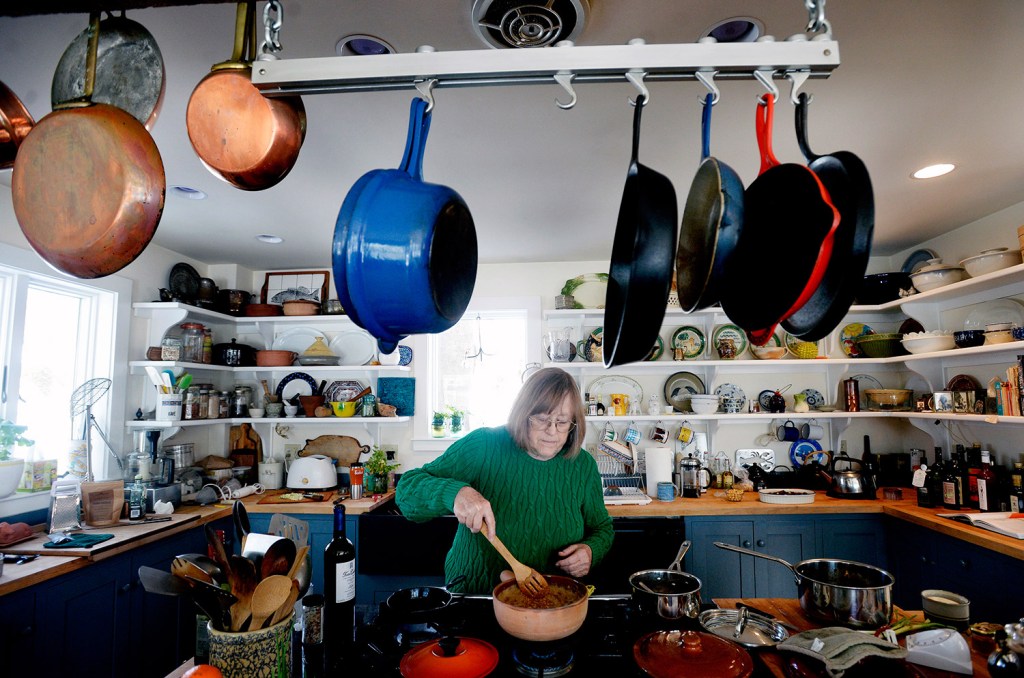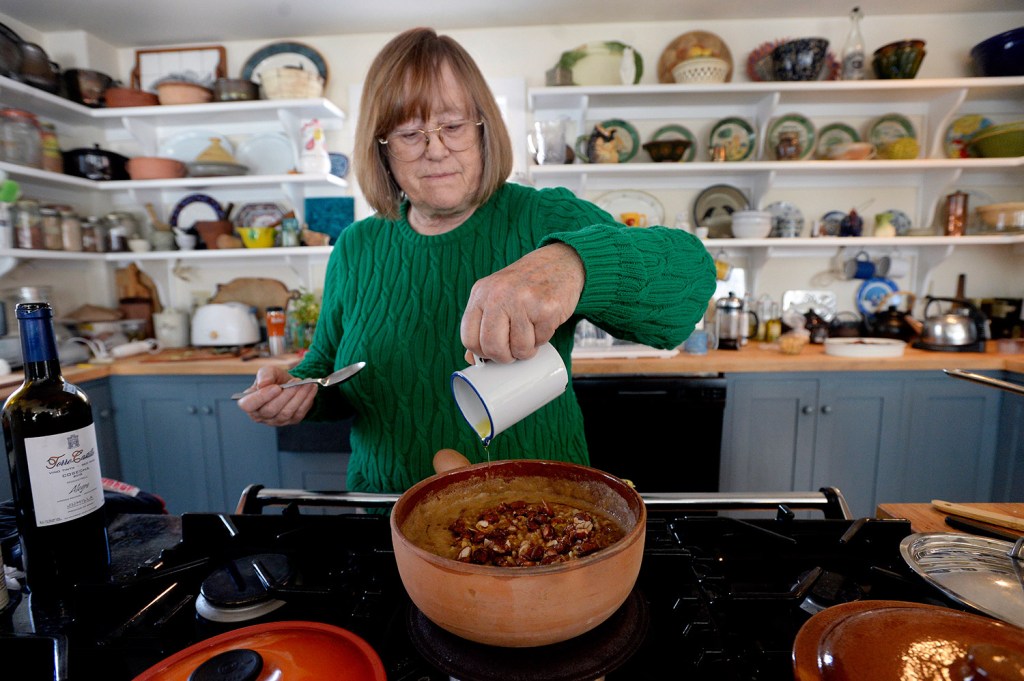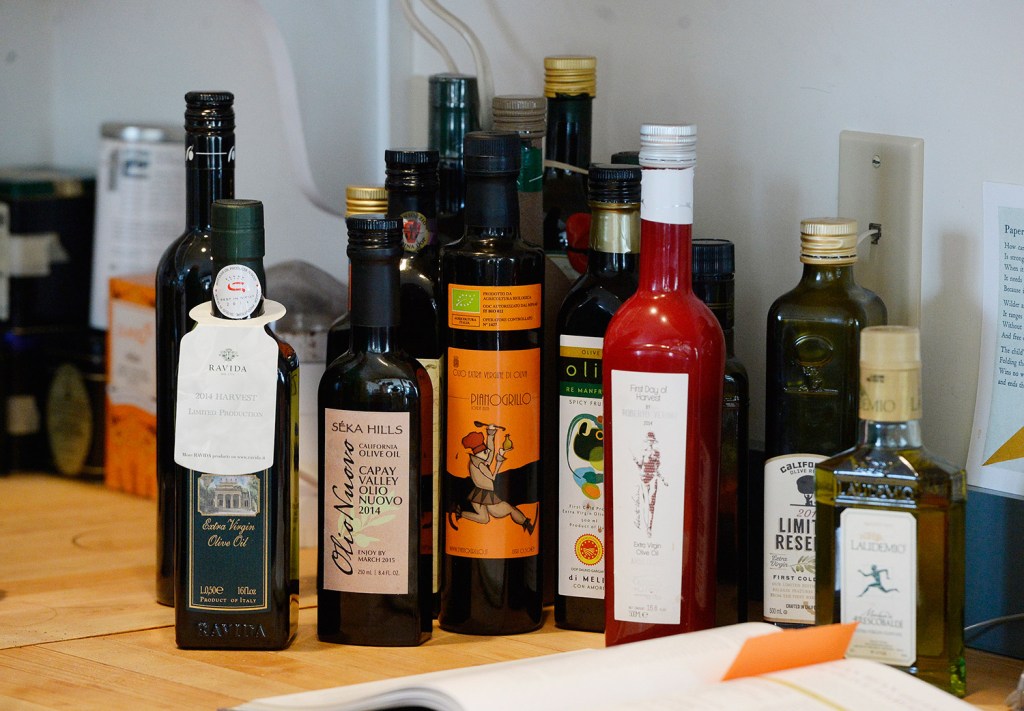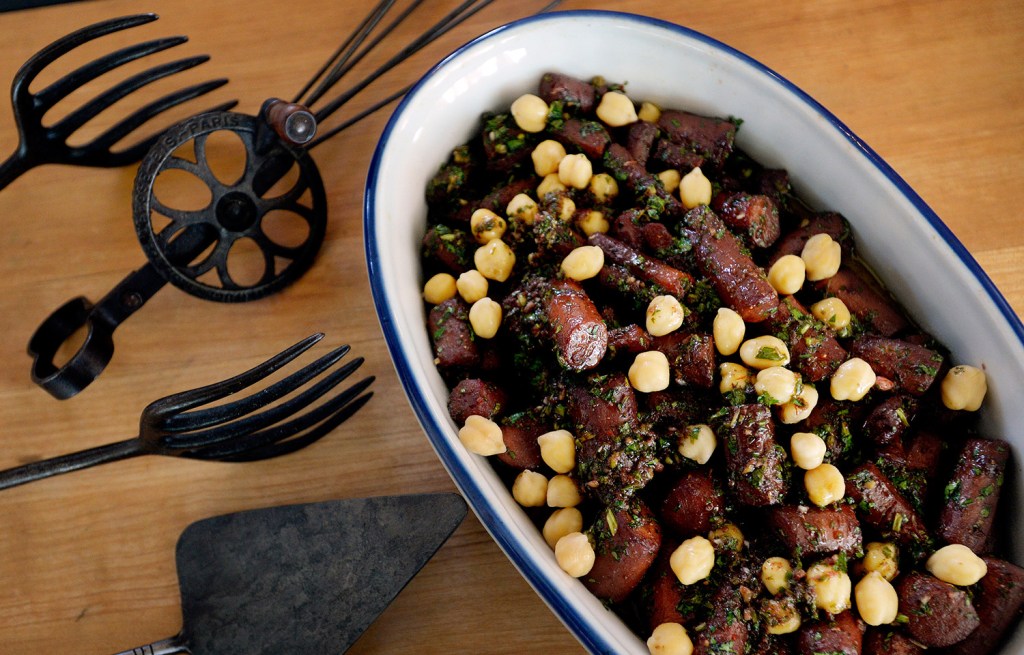CAMDEN — Just like sampling fine wine with a sommelier, or slurping great coffee at a coffee cupping, tasting olive oil with Nancy Harmon Jenkins opens a whole new world of flavors, nuances and possibilities.
Ask the well-known food writer and olive oil expert what her favorite olive oil tastes like, and she replies, “Let’s taste it and find out.” She pulls out two spoons and opens a bottle of Pianogrillo that’s sitting on her kitchen counter.
She discovered the Pianogrillo at a trattoria in Tuscany, and was so impressed she went to visit the maker in eastern Sicily. Like wines and coffees, olive oils can be made from one type of olive or a blend of olives from different trees. Pianogrillo is made from a single variety of olive, the Tonda Iblea.
“Just a little bit. It doesn’t take much. OK, now slurp it,” Jenkins said, making a loud noise as she sucked the oil in over her tongue and into the back of her mouth.
It tastes grassy, and there’s a spicy kick at the end from the polyphenols – the antioxidants in olive oil that protect your health.
“Very grassy,” Jenkins agreed. “And then it’s still got a certain amount of bitterness and pungency to it. It’s very well balanced. I think it’s a wonderful oil.”
Jenkins, already a nationally known expert on the Mediterranean diet, has just written a book that focuses exclusively on olive oil. “Virgin Territory: Exploring the World of Olive Oil” is part primer on olive oil, part cookbook – it includes more than 100 Mediterranean recipes – and part autobiographical account of producing olive oil on her own Tuscan farm. It’s the sixth book she’s written about Mediterranean food.
In her Camden kitchen, she has a Spanish olive oil she loves, a Greek oil someone sent her from a family estate, another Sicilian oil that is sweeter and nuttier than the Pianogrillo, and one of her new favorites, Séka Hills, an olive oil made by an Indian tribe in California.
“They are very careful about what they’re doing,” Jenkins said. “They’re harvesting and pressing immediately, and taking good care of the oil afterwards, which is what it takes to make good olive oil.”
There’s also a bottle of California Olive Ranch on the counter, which Jenkins says is a good all-purpose alternative she would use for cooking. And since it’s an industrial oil, the price is right.
Wait, what? It’s OK to cook with extra-virgin olive oil?
Jenkins answers with an enthusiastic yes. Sure, you’ll lose some of its antioxidant properties, but it’s an “absolutely ludicrous” myth that extra-virgin olive oil is not good for cooking, she said.
In Jenkin’s pantry is a Lebanese olive oil her visitor has always liked, but Jenkins quickly changes that opinion with an impromptu tasting, comparing it side by side with a better oil. The Lebanese oil, Jenkins explains, is “fusty,” which means the olives were kept too long before being pressed, and they started to ferment.
On Jenkins’ stove is a clay pot full of Tuscan Bean and Farro Soup. After dishing out a bowl, Jenkins slowly drizzles her own Tuscan olive oil on top. After the last harvest, she shipped home 24 liters of that oil from Italy, made from leccino olives harvested from trees planted in 1999. Jenkins was fortunate to have a harvest at all last year; many Mediterranean olive groves were decimated by the olive fly, which lays eggs inside the olives, and when the larvae hatch they eat their way out.
Jenkins consumes olive oil every day, beginning in the morning when she fries an egg in it or drizzles it on toast. The only other fats she keeps in the house are lard from the Blue Hill Farmers’ Market that she uses for pie crusts and duck fat she rendered herself that she uses for frying potatoes.
IT ALL STARTED IN ROME
How did a 13th-generation Mainer from midcoast Maine become an expert on olive oil?
Jenkins grew up in Camden and attended Gould Academy in Bethel. When she graduated, like a lot of Maine young people, she “just took off.” She traveled in Europe during college and then worked in New York for five years.
In the 1960s, Jenkins married Loren Jenkins, eventually a foreign correspondent and Pulitzer Prize winner who would work for the Washington Post, Newsweek and National Public Radio. The couple moved to London in 1966 and remained overseas for the next 15 years.
Jenkins got her master’s degree in Egyptology at the American University of Beirut. “I thought I was going to be an archaeology journalist,” she said, “and then it turned out the world was not exactly craving journalism about archaeology.”
After a stint in Hong Kong, the couple moved to Rome, where Nancy Jenkins fell into writing a book about a Fourth Dynasty boat that had been discovered buried next to the Great Pyramids. The book was well received, but Jenkins couldn’t get any more archaeology-related assignments.
Then journalist Mort Rosenblum, who was editor of the International Herald Tribune at the time and would go on to write his own book on olive oil, asked Jenkins if she’d like to write about food while she was in Rome. The rest, as they say, is history.
“We’d go to embassy cocktail parties and so forth, which my husband had to do as a journalist, and he would be introduced as Nancy Jenkins’ husband, which was just wonderful because I had always been introduced as Loren Jenkins’ wife,” Jenkins said, laughing. “So I had a great following in Rome, and I loved doing it.”
When Jenkins and her husband returned to the United States, they moved to Aspen, where they decided to get a divorce. Jenkins wrote for magazines, and her friend R.W. Apple, the renowned New York Times writer and editor, recruited her to the Times.
Jenkins worked for The New York Times for four years, but “I really hated living in New York,” she said.
DRAWN TO MEDITERRANEAN WAY
Next she became editor of the Journal of Gastronomy, which was published by the American Institute of Wine and Food. Her interest in olive oil began when she co-founded the Oldways Preservation Trust in Boston, a food-issues think tank that promotes healthy eating.
She worked with the International Olive Oil Council and the Harvard School of Public Health, which was investigating the Mediterranean diet – or “Mediterranean way of eating,” as Jenkins prefers.
Jenkins has written several books about the virtues of the Mediterranean diet, which is heavy on fruits, vegetables, seafood and complex carbohydrates, light on meat, and generous with olive oil.
“It’s a diet that can be followed just by going to the supermarket and being careful about what you shop for there,” Jenkins said. “It’s a diet that’s delicious, that’s very appealing to lots and lots of people, including small children. And it’s easy to prepare.”
In recent years, Jenkins began teaching classes on olive oil and the Mediterranean diet in Tuscany. At first she targeted chefs – Portland’s own Sam Hayward attended one of her courses, as did New York City chef Anita Lo and Montreal chef Michele Forgione – but for the most part, she says, “I can’t get chefs to budge out of their kitchens.” So now she has opened the classes to the public, and she’ll be holding them in Sicily this summer for the first time.
Jenkins’ life and travels are reflected on the shelves of her kitchen, which are packed with platters, bowls and pots she’s picked up around the world.
Propped in one corner is a green bowl given to her by the late Maine food writer Leslie Land. On another shelf, a row of plates from Sicily. There’s a Tunisian couscous pot, and a leek platter and a fennel teapot she bought years ago at Kitchen Arts & Letters in New York. On another shelf is a Japanese elephant she found in a Buenos Aires flea market. There are also lots of cookbooks, including copies of her own.
“This is my favorite book of all time,” Jenkins said, pointing to a copy of Marjorie Mosser’s “Good Maine Food.” “It’s been used and used and used.”
NEXT BOOK’S ABOUT PASTA
Jenkins’ usual schedule is to travel to Italy in late March and stay until the end of June, when she returns to Maine for three months. Then she returns to Italy from October through December. But she is starting to spend more time in Maine now, partly because her Italian farmhouse is so isolated – and cold.
“It’s an old stone farmhouse, with very thick walls, that absorbs every bit of moisture in the air, and it’s not as much fun as it used to be,” Jenkins said. “The other thing is, traveling has gotten to be so disagreeable.”
She’s also got plenty of work to do here. She’s been doing book tours for “Virgin Territory,” and a copy-edited manuscript of her next book has already landed in her email box. It’s called “The Four Seasons of Pasta,” and she co-wrote it with her daughter, New York City chef/restaurateur Sara Jenkins.
Spending less time with her olive trees in Italy, Jenkins said, won’t make her sad, “because Maine is so interesting and so beautiful, and my roots are here.”
TUSCAN BEAN AND FARRO SOUP
FOR THE OLIVE HARVEST
This is the hearty soup Nancy Harmon Jenkins serves for lunch during the olive harvest at her Tuscan farm.
Serves 8-10
11/2 cups dried beans, preferably speckled cranberry beans or borlotti, soaked for several hours or overnight
1 medium carrot, chopped
2 small yellow onions, 1 chopped
1 or 2 bay leaves
11/2 cups farro
4 garlic cloves
1/2 cup olive oil
Sea salt and freshly ground black pepper
8 to 10 thin slices dense, grainy Italian country-style bread, preferably at least a day old
4 to 6 tablespoons olio nuovo (fresh new olive oil), if available, for serving
2 tablespoons finely minced flat-leaf parsley, or more
Drain the beans, and discard the soaking water. Place the beans in a large saucepan with the carrot, chopped onions and bay leaf (or leaves). Cover with fresh water, bring to a boil, lower the heat, and simmer, covered, until the beans are very soft, 40 minutes to 2 hours, depending on the age of the beans. Keep a kettle of water simmering, and add more water to the beans as they absorb the liquid. They should always be just covered with water but never swimming in it.
The farro should not need soaking, but it should be rinsed briefly in a colander to get rid of any dust. In a medium saucepan, cover the rinsed and drained farro with boiling water to a depth of 1 inch. Bring to a simmer and cook, covered, for 20 to 30 minutes, until the farro is tender.
When the beans are very soft, set aside about 1/2 cup whole beans. Discard the bay leaves and puree the remainder of the beans, with all their liquid and the vegetables that were cooked with them, in a food processor or put through a food mill. Drain the farro and add to the pureed beans. Stir in the reserved whole beans.
Chop the remaining onion with 3 of the garlic cloves until finely minced. Over medium heat, sauté the onion and garlic in 1/4 cup of the oil until soft. Add to the pureed beans and mix well. Taste and add salt and plenty of pepper.
Lightly toast the bread slices. Halve the remaining garlic clove, and rub the slices well with the garlic on both sides. When ready to serve, set a toast slice in the bottom of each soup plate and dribble a liberal dose of fresh new oil over each slice. Spoon hot soup over the bread and add another dollop of oil to the top of each serving, without stirring it in. Sprinkle with the parsley and serve immediately, passing more fresh new oil to pour over the top.
CARROTS AND CHICKPEAS
IN CHERMOULA SAUCE
Chermoula comes from Morocco. The red wine will color the carrots prettily. For “more punch,” Nancy Harmon Jenkins toasts the cumin and coriander seeds in a dry skillet over medium heat until the fragrance rises and the seeds begin to smoke; then she grinds them to powder in a spice grinder.
Makes 6 or more servings
FOR THE CARROTS:
2 to 3 pounds carrots, peeled and cut into irregular, 2-inch chunks
1/4 cup olive oil
Water or red wine
FOR THE CHERMOULA:
3 garlic cloves, crushed with the flat blade of a knife
1 bunch cilantro, finely minced
About 1/3 cup finely minced flat-leaf parsley
1 teaspoon harissa, or to taste
1 teaspoon sea salt
1 teaspoon mild paprika
1 teaspoon ground toasted cumin seeds
1/2 teaspoon ground toasted coriander seeds
Pinch of saffron
1/2 cup olive oil
2 tablespoons freshly squeezed lemon juice or red wine vinegar, or more to taste
Ground hot red chile pepper (optional)
1 cup cooked chickpeas
1 cup cooked chopped spicy or bitter greens (optional)
TO MAKE THE CARROTS:
Put the carrots in a saucepan with the oil and cook over medium-high heat, stirring, until they start to brown along the edges. Add water or red wine just to cover them and cook, partially covered, until they are barely tender, 10 to 15 minutes.
TO MAKE THE CHERMOULA:
Chop the garlic, cilantro and parsley together to make a very fine mince. Transfer to a bowl and stir in the harissa, salt, paprika, cumin and coriander. Crumble the saffron into the mixture, then beat in the oil and lemon juice. Taste and adjust the seasoning. If it’s not spicy enough, add chile pepper or more harissa.
As soon as the carrots are done, drain them and, while they are still hot, pour the chermoula sauce over. Stir gently to cover the carrot pieces with the sauce. Set aside to marinate for at least 30 minutes before serving.
Add cooked chickpeas and cooked spicy greens, if you wish. Serve at room temperature or a little warmer but neither piping-hot nor chilled from the refrigerator.
Send questions/comments to the editors.








Comments are no longer available on this story